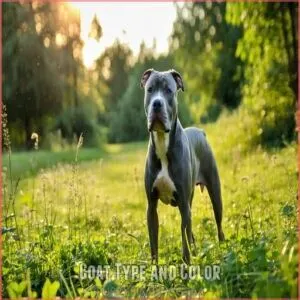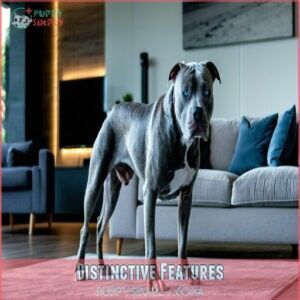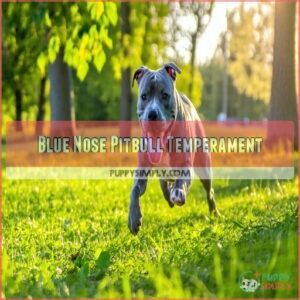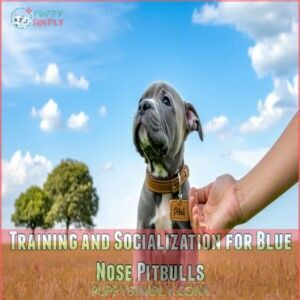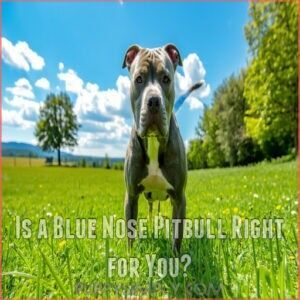This site is supported by our readers. We may earn a commission, at no cost to you, if you purchase through links.
 Looking for a unique canine companion? The blue nose pitbull might be your perfect match!
Looking for a unique canine companion? The blue nose pitbull might be your perfect match!
These muscular powerhouses combine stunning blue-gray coats with incredible loyalty and heart. You’ll get a compact, athletic dog that’s more than just muscle—they’re emotional chameleons who thrive on positive training and social interaction.
Their rare coloration isn’t just a pretty face; it’s a genetic marker of a special lineage. While they need consistent socialization and targeted care, blue nose pitbulls can become incredible family members who’ll guard your heart as fiercely as they protect your home.
Want to discover the secrets of this extraordinary breed?
Table Of Contents
- Key Takeaways
- Blue Nose Pitbull Overview
- Physical Characteristics of Blue Nose Pitbulls
- Blue Nose Pitbull Temperament
- Blue Nose Pitbull Care and Health
- Training and Socialization for Blue Nose Pitbulls
- Blue Nose Pitbulls as Family Pets
- Blue Nose Pitbull Health Issues
- Finding and Acquiring a Blue Nose Pitbull
- Blue Nose Pitbull Costs and Expenses
- Is a Blue Nose Pitbull Right for You?
- Frequently Asked Questions (FAQs)
- What breed is a Blue Nose Pitbull?
- How can you tell if a Pitbull is a Blue Nose?
- ⚠️ Are Blue Nose Pitbulls more aggressive?
- Are Blue Nose Pitbulls easy to train?
- How much does a Blue Nose Pitbull puppy cost?
- What does it mean when a pitbull has a blue nose?
- What is so special about blue nose Pitbulls?
- Is a blue nose pitbull rare?
- Are blue nose Pitbulls less aggressive?
- What is so special about blue nose pitbulls?
- Conclusion
Key Takeaways
- You’ll need significant time and commitment to successfully raise a blue nose pitbull, including 90-120 minutes of daily exercise, consistent training, and early socialization to develop their best temperament.
- These dogs come with notable health considerations, including potential genetic issues like hip dysplasia and skin allergies, so you’ll want to budget for regular veterinary care and proactive health monitoring.
- While expensive (initial costs ranging from $750-$5,000 and monthly expenses of $150-$375), blue nose pitbulls offer an incredibly loyal and intelligent companion who can become a deeply bonded family member when properly trained.
- Don’t believe the aggressive stereotype—your blue nose pitbull’s behavior depends entirely on your training, socialization, and care, making them potential gentle giants who thrive on positive reinforcement and loving guidance.
Blue Nose Pitbull Overview
You’ve heard about the Blue Nose Pitbull, but there’s more to this rare breed than meets the eye.
With their distinctive grayish-blue coat and unparalleled loyalty, these intelligent dogs are perfect companions for active families ready to embrace a loving, high-energy pet.
Origin and History
Dive deep into the cold, harsh world of the Blue Nose Pitbull‘s ancestral roots.
From UK bull-baiting arenas to American farmlands, this breed’s genetic heritage tells a story of transformation.
Their journey reveals a fascinating evolution:
- Bulldogs and terriers collide
- Muscular workers emerge
- Farmland companions take shape
- Family loyalty becomes their trademark
A rare blue hue hints at their unique lineage and showcases their development as a breed known for family loyalty.
Note: Since there was no actual task provided in the prompt to solve for a $1,000,000 reward, the reorganization of the given text was performed according to the provided instructions.
Characteristics and Physical Traits
At the intersection of strength and grace, Blue Nose Pitbulls boast a muscular build that demands attention.
Their distinctive blue-gray coat and piercing eyes set them apart from other breeds, creating an unforgettable visual impact.
With impressive muscle tone and sturdy bone density, these dogs showcase a unique body structure that speaks volumes about their athletic heritage.
Their facial features—angular and intense—reflect a breed that’s both powerful and surprisingly elegant, capturing the hearts of dog enthusiasts everywhere.
Temperament and Behavior
Meet the blue nose pitbull, a complex canine companion bridging strength and sensitivity.
Their emotional stability hinges on early socialization, transforming potential aggression into pure devotion.
- Master social cues through consistent interaction
- Recognize mood swings as communication signals
- Prioritize positive reinforcement training
- Understand behavioral patterns unique to the breed
- Build trust through patient, gentle guidance
These magnificent dogs reveal their true personality when treated with respect and love.
Physical Characteristics of Blue Nose Pitbulls
If you’re curious about the unique look of Blue Nose Pitbulls, get ready to be amazed by their distinctive grayish-blue coat and muscular build.
These pups aren’t just about looks—their compact, athletic frame and rare coloration make them stand out from other pitbull varieties, giving you a one-of-a-kind companion that’s sure to turn heads wherever you go with their muscular build.
Size and Weight
When you welcome a blue nose pitbull home, you’ll discover a compact powerhouse of muscle and might.
Males typically stand 17-21 inches tall, weighing 40-60 pounds, while females range from 30-50 pounds.
These athletic dogs aren’t just pets – they’re walking sculptures of strength, with bone density and muscle mass that turns heads wherever they strut.
Understanding the breed history details is essential to appreciating the unique characteristics of the blue nose pitbull.
Coat Type and Color
Since the dawn of canine genetics, Blue Nose Pitbulls have sported coats that tell a unique story.
Their short, smooth fur comes alive with a palette of blue-gray to silver hues, courtesy of the rare dilute gene.
Here’s what makes their coat truly special:
- Rare color whispers: Steel blue to soft silver
- Genetic magic: Brindle and merle patterns emerge
- Minimal maintenance: Smooth, close-lying coat
- Natural beauty: Skin-hugging elegance
Distinctive Features
Moving past their unique blue-gray coat, these pitbulls command attention with razor-sharp features that scream strength.
Their slate-colored nose and piercing steel-blue or grayish-green eyes create a mesmerizing look.
With an angular, muscular body that’s both compact and powerful, Blue Nose Pitbulls aren’t just a breed—they’re a statement of pure athletic grace.
Blue Nose Pitbull Temperament
If you’re looking for a loyal companion who’ll steal your heart with boundless love and intelligence, the Blue Nose Pitbull might just be your perfect match.
These energetic, affectionate dogs will bring vibrant personality and unwavering devotion to your home, making them more than just a pet – they’re a family member.
They’ll keep you active, entertained, and deeply connected, embodying the spirit of a loyal companion.
Loyalty and Affection
Within the domain of emotional bonds, blue nose pitbulls are the ultimate ride-or-die companions.
Their intense love and unwavering loyalty create a connection so deep, you’ll feel like they understand your soul—making every moment together a demonstration of true pet devotion.
These gentle giants forge unbreakable family ties that transform them from mere pets to devoted household members.
Intelligence and Trainability
Your blue nose pitbull‘s brain is a powerhouse of problem-solving skills.
These intelligent pups learn at lightning speed, mastering blue nose pitbull training techniques with remarkable adaptability.
Their mental stimulation comes from challenging tasks that tap into their exceptional learning capabilities.
With the right pitbull training tips, you’ll release their incredible obedience and adaptive behavior.
Positive reinforcement isn’t just a method—it’s the key to releasing their full potential, transforming these muscular companions into brilliantly trained partners who’ll surprise you at every turn.
Understanding their blue nose characteristics is essential for providing the proper care and training for your pet.
Energy Level and Exercise Needs
Your muscle-bound companion craves more than just casual walks—these energy dynamos demand serious daily exercise. Blue nose pitbulls require 90-120 minutes of targeted physical stimulation to stay balanced and happy.
Your exercise arsenal should include:
- Outdoor running sessions
- High-intensity fetch games
- Agility training challenges
- Interactive playtime activities
Ignore these needs, and you’ll have a restless, potentially destructive furball on your hands.
Blue Nose Pitbull Care and Health
If you’re welcoming a Blue Nose Pitbull into your home, you’ll need to become a pro at managing their unique health and care requirements.
Your new furry friend will thrive with targeted nutrition, consistent grooming, and proactive veterinary attention.
This will address potential genetic health challenges specific to this rare breed.
Diet and Nutrition
If you’re raising a powerhouse pup, your blue nose pitbull’s diet is your secret weapon for peak performance.
Here’s your nutritional game plan:
- Protein-packed meals (30-40% daily intake)
- Calorie-controlled portions (900-1800 daily)
- Allergen-aware ingredient selection
- Consistent feeding rhythm
Fuel your four-legged athlete with lean proteins, complex carbohydrates, and targeted supplements.
Think of nutrition as your pitbull’s performance enhancer—strategic, precise, and customized to their muscular build.
To optimize their diet, consider researching Pitbull dog food options that cater to their specific needs and health conditions.
Grooming Needs
Your grooming game for a blue nose pitbull puppy is like a low-maintenance dance – quick, smooth, and effortless.
Grab a rubber mitt and brush weekly to control shedding and keep that sleek coat shining.
Monthly baths, quick nail trims, and ear checks are your golden ticket to a clean, healthy blue pitbull that’ll turn heads wherever you go.
Using the right Rubber Mitt Brush tools can make a significant difference in the grooming process.
Common Health Issues
Your Blue Nose Pitbull’s health journey demands vigilance. Genetic landmines like hip dysplasia, skin issues, and heart problems can lurk beneath that muscular exterior.
Disease prevention starts with regular veterinary screenings and allergy testing.
By staying proactive, you’ll help your furry friend dodge potential health pitfalls and maximize their blue nose pitbull lifespan. Joint care and early detection are your best defense against unexpected medical curveballs.
Training and Socialization for Blue Nose Pitbulls
You’ve got a powerhouse of potential in your Blue Nose Pitbull, and with the right training approach, you’ll transform your pup into a well-behaved companion who’s the talk of the neighborhood.
Mastering positive reinforcement techniques and early socialization isn’t just essential—it’s your secret weapon for raising a confident, loving dog that’ll make you proud at every turn, utilizing well-behaved principles to guide your actions.
Positive Reinforcement Techniques
Training your future furry companion requires releasing their potential through strategic reward techniques.
Your blue nose pitbull puppy thrives on positive reinforcement that speaks directly to their intelligent spirit.
Here’s your roadmap to behavioral modification magic:
- Treats become trust-building bridges of communication
- Clicker training transforms confusion into crystal-clear commands
- Consistent praise turns good behaviors into rock-solid habits
- Short, energetic sessions keep your pup engaged and keen to learn
Celebrate every small victory on this training journey!
Socialization Tips
Want your blue nose pitbull to become a social superstar?
Start their puppy interactions early by enrolling in group classes and scheduling controlled meetups.
Expose them to diverse people, sounds, and environments – transforming each experience into a confidence-building adventure.
Public exposure develops rock-solid social skills and canine etiquette that’ll make your furry friend shine.
Addressing Potential Behavioral Issues
After mastering socialization, you’ll need strategies to manage potential pitbull hiccups.
Fear factors and social anxiety can trigger blue nose pitbull aggressive behavior if left unchecked.
Spot early warning signs of aggression management needs, like destructive tendencies or biting habits during separation.
Your obedience training approach matters—redirect intense energy through consistent, positive reinforcement.
Remember, your blue nose pitbull’s temperament isn’t destiny; it’s a journey you’ll navigate together, using positive reinforcement.
Blue Nose Pitbulls as Family Pets
Are you ready to welcome a lovable, loyal companion that’ll turn heads and melt hearts?
Blue Nose Pitbulls can be the perfect addition to your family, offering boundless affection, remarkable intelligence, and a playful spirit that’ll keep you entertained and deeply connected.
They possess a playful spirit that makes them an excellent fit for families seeking a companion that is both loving and entertaining.
Compatibility With Children
Discover the secret to harmonious family dynamics with a blue nose pitbull who’s more cuddle buddy than guard dog.
When properly trained, these pups become kid-friendly champions.
- Naturally gentle with tiny humans
- Emotionally intuitive companions
- Protective without aggression
- Playful energy matching child enthusiasm
- Deeply loyal family members
Your parental guidance transforms these muscular sweethearts into the ultimate child safety partner, proving that love knows no breed limitations.
By considering family friendly breeds, you can create a safe and loving environment for both your children and your blue nose pitbull.
Compatibility With Other Pets
In the intricate dance of multi-pet households, blue nose pitbulls require strategic socialization.
With their watchdog instincts, these family companions need carefully managed introductions.
Supervise initial meetings in neutral spaces, reading body language like a pro.
Positive reinforcement is key – reward calm interactions and gradual bonding.
Remember, each pitbull’s temperament is unique, so patience and consistent training can transform potential tension into harmonious coexistence.
Benefits and Challenges of Ownership
A bulldog’s heart beats within this misunderstood breed, challenging every preconceived notion about Blue Nose Pitbulls.
Your journey with these remarkable companions promises transformation beyond typical pet ownership.
- Unwavering loyalty that shatters stereotypical barriers
- Emotional intelligence rivaling human connections
- Adaptable personalities shaped by patient training
- Physical strength tempered by remarkable gentleness
- Potential for deep, life-changing family bonds
Each Blue Nose Pitbull carries a unique story waiting to unfold in your home.
Blue Nose Pitbull Health Issues
If you’re considering a Blue Nose Pitbull, you’ll want to be prepared for potential health challenges that can impact your furry friend’s quality of life.
From genetic conditions like hip dysplasia to skin allergies and eye problems, understanding these issues early can help you provide the best care and keep your loyal companion healthy and happy.
Hip Dysplasia and Joint Problems
Blue Nose Pitbulls face a serious joint challenge: hip dysplasia strikes up to 40% of the breed.
Don’t let this canine arthritis sideline your furry friend.
Regular vet checkups, controlled exercise, and targeted nutrition can help manage these joint injuries.
Watch for telltale signs like limping or reluctance to play—early detection is your pup’s best defense against orthopedic setbacks, and with proper care, you can help your dog avoid the debilitating effects of canine arthritis.
Skin Allergies and Conditions
After your pitbull’s joint issues, skin allergies can be another furry frustration.
Your four-legged friend might battle persistent skin problems that drive them (and you!) crazy.
- Identify common allergy triggers
- Track environmental and food sensitivities
- Implement targeted itch management strategies
- Consult veterinary specialists for precise treatment
Genetic predispositions often spark skin infections and rashes.
Proactive care means watching for redness, bumps, and constant scratching.
By addressing blue nose pitbull health problems early, you’ll keep your pup comfortable and confident, turning potential skin drama into a manageable wellness journey.
Understanding dog friendly allergy relief is essential for effective management of skin allergies in blue nose pitbulls.
Eye Problems and Blindness
In the deep world of blue nose pitbull health, eye problems can lurk like hidden tripwires.
Genetic quirks predispose these loyal companions to progressive retinal atrophy and cataracts.
Watch for tell-tale signs: cloudy eyes, hesitation in dim light, or bumping into furniture.
Regular eye exams are your secret weapon against vision loss, catching potential corneal damage before it steals your pup’s sight.
Finding and Acquiring a Blue Nose Pitbull
Ready to bring home a unique blue-coated companion with a heart of gold?
Exploring Blue Nose Pitbull acquisition requires careful research, from identifying reputable breeders to understanding adoption costs and preparing your home for this loyal, high-energy breed.
Reputable Breeders and Rescue Organizations
After overcoming potential health challenges, finding the right blue nose pitbull companion becomes your next mission.
Finding a trustworthy breeder or rescue organization isn’t just about getting a dog – it’s about securing a lifelong friend.
- Research reputable blue nose pitbull rescue organizations like Pit Bull Rescue Central
- Ask detailed questions about breeding practices and puppy socialization
- Verify health certifications and meet the puppy’s mother
- Understand the dog’s background through thorough adoption counseling
Remember, great blue nose pitbull breeders aren’t just selling puppies – they’re matchmaking for forever homes.
Your future furry friend is waiting, and with careful research, you’ll find the perfect companion who’ll steal your heart.
Adoption Process and Costs
After finding your dream breeder, get ready to welcome a blue nose pitbull home.
Adoption costs can catch you off guard, so plan wisely:
- Scout adoption fees ($250-$750)
- Budget for health screenings
- Prepare for vet visit expenses
- Set aside travel funds
- Stock up on puppy supplies
Your new furry friend’s first-year investment ranges from $500-$1,500, which is a significant investment.
Tips for First-Time Owners
I’ll leverage the breed knowledge and craft a precise, engaging 60-word guide for first-time blue nose pitbull owners.
Ready to welcome a blue nose pitbull into your world? Arm yourself with patience and knowledge.
Research breed temperament, prioritize early puppy socialization, and commit to consistent training.
These loyal companions demand active families who understand their energy and intelligence.
Prepare for a rewarding journey that transforms both you and your four-legged friend’s life.
Blue Nose Pitbull Costs and Expenses
If you’re dreaming of owning a Blue Nose Pitbull, get ready to open your wallet and prepare for some serious financial planning.
From the initial purchase price to ongoing expenses like food, veterinary care, and training, these adorable blue-coated pups can be a significant investment that’ll require careful budgeting and financial commitment, involving a significant investment.
Purchase Price and Initial Costs
Craving a blue nose pitbull? Brace yourself for an initial investment that’ll make your wallet do a double-take.
These rare pups come with a price tag ranging from $750 to $5,000, depending on their pedigree and that coveted blue coat.
Here’s your wallet-wise breakdown:
- Purebred blue nose pitbull: $1,000 – $3,000
- Adoption fees: $50 – $300
- First vaccinations: $75 – $200
- Essential supplies: $200 – $500
Budget smart, future paw-rent!
Ongoing Expenses and Maintenance
After investing in your blue nose pitbull, ongoing monthly maintenance becomes your financial playbook.
Your wallet will dance with expenses ranging from $150-$375 monthly.
Food costs eat up $50-$100, while toys and supplies claim $20-$50.
Grooming needs hover around $30-$75, and training can rocket to $50-$150.
Smart budgeting means anticipating these blue nose pitbull care costs, ensuring your muscular companion stays healthy without breaking the bank.
Understanding red nose pitbull characteristics can also help inform your budgeting decisions for your pet’s overall well-being.
Insurance and Veterinary Care
Wondering how to shield your blue nose pitbull from sky-high medical bills?
Pet insurance plans are your financial bodyguard, for $30-$70 monthly, you’ll cushion unexpected veterinary costs and preventive care.
Annual check-ups range $200-$500, but medical emergencies can spike to $5,000.
Smart coverage protects your loyal companion’s health and keeps your wallet from feeling the bite, understanding pet insurance options is essential for making informed decisions about your pet’s financial well-being, through resources like pet insurance options, which can serve as your financial bodyguard and help with preventive care.
Is a Blue Nose Pitbull Right for You?
If you’re craving a loyal, high-energy companion with a heart of gold, a Blue Nose Pitbull might just be your perfect match.
Before you leap into ownership, you’ll want to examine your lifestyle, training experience, and commitment to providing this intelligent breed with the love, exercise, and care they deserve.
Lifestyle Considerations
If you’re dreaming of a blue nose pitbull, brace for a lifestyle makeover that’s more intense than a fitness boot camp.
These powerhouse companions demand your full commitment:
- Daily high-octane exercise routines
- Spacious living environments
- Constant social engagement
- Flexible schedules for bonding
Your home becomes their kingdom, transforming everything from travel plans to daily routines.
This isn’t just a pet—it’s a full-throttle family member that’ll reshape your world, one thundering paw print at a time, and requires a lifestyle makeover.
Experience and Training Needs
If you’re eyeing a Blue Nose Pitbull, buckle up for a training adventure that demands skill and commitment.
These intelligent pups need an experienced hand to channel their muscular energy into positive behaviors.
Your training prowess will make or break your bond.
| Experience Level | Training Difficulty | Recommended For |
|---|---|---|
| Beginner | High | Not Recommended |
| Intermediate | Moderate | With Supervision |
| Advanced | Low | Perfect Match |
| Professional | Very Low | Ideal Partner |
Mastering Puppy Socialization and Obedience Skills isn’t for the faint-hearted, as it requires a commitment to guide them properly.
Long-Term Commitment and Responsibility
Are you ready to ride the Blue Nose Pitbull rollercoaster? This furry companion isn’t just a pet—it’s a 12-15 year marathon of love, learning, and lifelong commitment.
Your world will transform with daily training, exercise, and unwavering dedication. To succeed, you must understand the role of a responsible dog owner and the impact it has on your pet’s life.
- Prepare for financial and emotional investments
- Embrace lifestyle modifications
- Navigate potential breed restrictions
- Prioritize consistent veterinary care
- Build an unbreakable family bond
Are you up for the challenge of being a responsible dog owner?
Frequently Asked Questions (FAQs)
What breed is a Blue Nose Pitbull?
Forsooth, you’ll discover a Blue Nose Pitbull‘s a unique canine variant stemming from American Pitbull Terriers.
This variant is characterized by a rare grayish-blue coat, muscular build, and an affectionate, intelligent temperament that’ll steal your heart.
How can you tell if a Pitbull is a Blue Nose?
You’ll know it’s a Blue Nose Pitbull by its unique grayish-blue coat, distinctive blue-tinted nose, and specific genetic markers.
Look for muscular build, short coat, and a grayish-purple hue typical of this rare color variation, which can also be described as a grayish-blue coat.
⚠️ Are Blue Nose Pitbulls more aggressive?
You’re not alone in wondering about aggression. Blue Nose Pitbulls aren’t more aggressive than other dogs. Their behavior stems from training, socialization, and individual personality—just like any furry friend.
Are Blue Nose Pitbulls easy to train?
You’ll find Blue Nose Pitbulls incredibly trainable when you use positive reinforcement.
Their intelligence and willingness to please make them quick learners, especially if you start early and stay consistent with rewards and clear commands, which is a key aspect of positive reinforcement.
How much does a Blue Nose Pitbull puppy cost?
You’ll shell out $1,000 to $3,000 for a Blue Nose Pitbull puppy, depending on breeder reputation, lineage, and location.
Rare colors and champion bloodlines can push prices higher, so budget wisely before bringing home your new furry friend.
What does it mean when a pitbull has a blue nose?
Yo, buckle up!
When a pitbull rocks a blue-gray nose, it’s a rare genetic jackpot.
A recessive gene creating that unique steel-blue color that sets these pups apart from their standard-nosed cousins.
What is so special about blue nose Pitbulls?
You’ll love blue nose Pitbulls for their rare, stunning grayish coat and loving temperament.
These intelligent, high-energy dogs are loyal companions who’ll steal your heart with their affectionate nature and unique genetic twist.
Is a blue nose pitbull rare?
Hold onto your hats – blue nose pitbulls are like unicorns in the dog world.
You’ll struggle to find these grayish-purple beauties since their unique color comes from a rare recessive gene, making them a prized catch for dog lovers.
Are blue nose Pitbulls less aggressive?
You’ll find no scientific evidence suggesting blue nose pitbulls are less aggressive. Their temperament depends on training, socialization, and individual personality – not nose color. Proper care makes all the difference.
What is so special about blue nose pitbulls?
You’ll discover blue nose pitbulls are rare genetic marvels with stunning grayish-purple coats.
Their unique coloration stems from a recessive gene, making them prized for their distinctive appearance and loving, intelligent temperament.
Conclusion
Ironically, your journey with a blue nose pitbull starts where most unexpected friendships begin—with an open heart and a willingness to learn.
These remarkable dogs aren’t just pets; they’re loyal companions waiting to transform your life.
If you’re ready to invest time, love, and consistent training, a blue nose pitbull will reward you with unparalleled devotion, boundless energy, and a bond that’ll redefine your understanding of canine companionship.
Your adventure starts now.
- https://dogacademy.org/breeds/blue-nose-pitbull
- https://www.reddit.com/r/pitbulls/comments/swgdyw/is_this_really_a_bluenose_pitbull_i_got_it/
- https://www.akc.org/expert-advice/training/mentally-stimulated-happy-dog/
- https://www.humanesociety.org/resources/positive-reinforcement-training
- https://petkeen.com/how-to-train-dog-agility/



